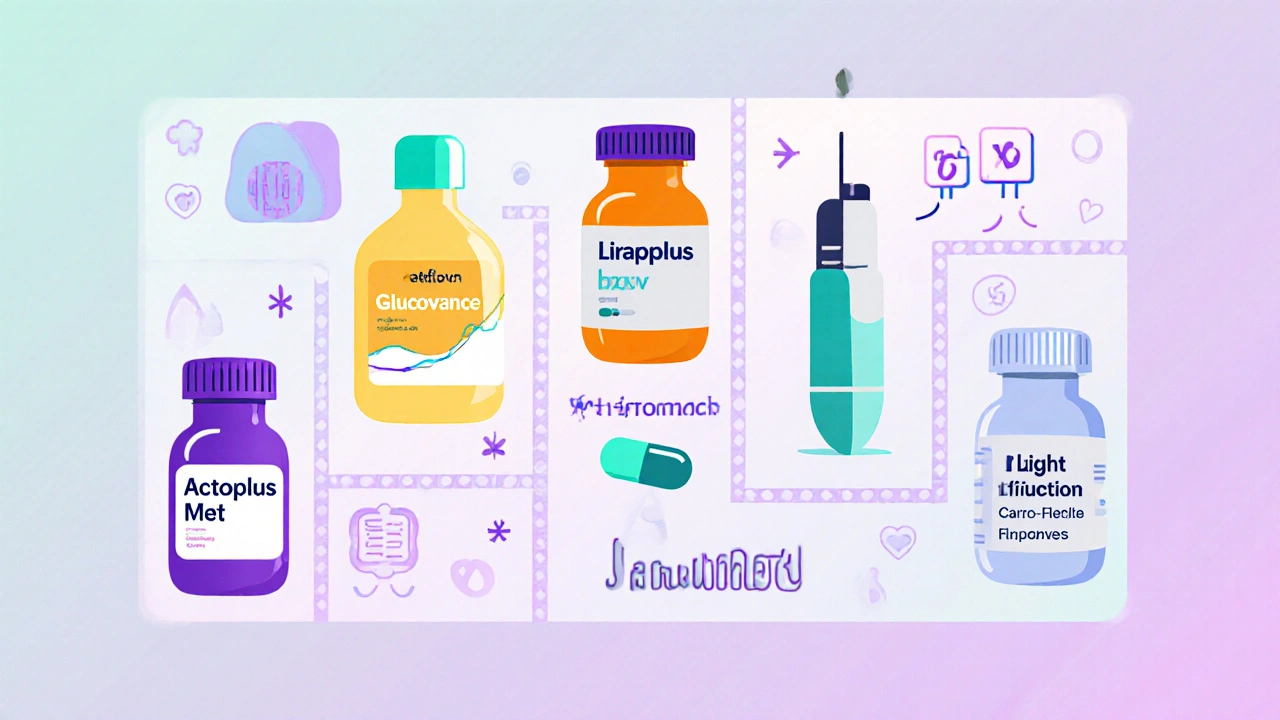Diabetes Medication Decision Tool
Medication Selection Guide
This tool helps you understand which diabetes medication might be most appropriate for your specific health situation. Based on information from the article, it considers key factors like heart health, kidney function, and weight management goals.
Recommended Medication
Actoplus Met comparison helps anyone with type 2 diabetes decide if this combo pill fits their needs or if another option makes more sense.
What is ActoplusMet?
Actoplus Met is a fixed‑dose tablet that combines Metformin (a biguanide) with Pioglitazone (a thiazolidinedione). The typical strength is 500mg Metformin plus 15mg Pioglitazone, taken twice daily with meals.
Metformin works primarily by reducing liver glucose production and improving insulin sensitivity in muscle. Pioglitazone also boosts insulin sensitivity, but it does so by activating PPAR‑γ receptors in fat cells, which helps the body store glucose more efficiently.
Because both agents target insulin resistance, the combo can lower HbA1c by about 1.5-2.0percentage points when added to diet and exercise.
Who might benefit from a combined tablet?
- Patients already on separate Metformin and Pioglitazone tablets who want fewer pills.
- Those whose HbA1c remains above target despite Metformin alone.
- Individuals without a history of heart failure, because Pioglitazone can increase fluid retention.
- People without severe liver disease, as Pioglitazone is metabolized in the liver.
If any of these points raise a red flag, an alternative regimen might be safer.
Key alternatives to ActoplusMet
Below are the most common options doctors consider when they want to move beyond Metformin monotherapy.
| Medication | Class | Typical Dose | HbA1c Reduction | Common Side Effects | Notable Contra‑indications |
|---|---|---|---|---|---|
| Actoplus Met | Biguanide + Thiazolidinedione | 500mg/15mg BID | 1.5-2.0% | GI upset, weight gain, edema | NYHA Class III/IV heart failure, severe liver disease |
| Glucovance | Biguanide + Sulfonylurea | 500mg/5mg BID | 1.8-2.2% | Hypoglycemia, GI upset | Renal impairment, elderly prone to hypoglycemia |
| Janumet | DPP‑4 inhibitor + Biguanide | 100mg/500mg BID | 1.0-1.4% | URIs, mild GI upset | Pancreatitis history |
| Empagliflozin | SGLT2 inhibitor (monotherapy or add‑on) | 10mg daily | 0.7-1.0% | Genital infections, dehydration | Severe renal impairment, ketoacidosis risk |
| Liraglutide | GLP‑1 receptor agonist (injectable) | 1.2mg daily | 1.0-1.5% | Nausea, vomiting, pancreatitis | Medullary thyroid carcinoma, multiple endocrine neoplasia type 2 |

How ActoplusMet stacks up against each alternative
Efficacy: In head‑to‑head trials, Actoplus Met cuts HbA1c a little less than Glucovance (a sulfonylurea combo) but more than DPP‑4 based combos like Janumet. SGLT2 inhibitors and GLP‑1 agonists tend to have similar or slightly better reductions, plus extra cardio‑renal benefits.
Safety profile: The biggest trade‑off is Pioglitazone‑related weight gain and fluid retention, which can worsen heart failure. Sulfonylureas (Glucovance) bring a higher hypoglycemia risk, especially in older adults. DPP‑4 inhibitors (Janumet) are usually well‑tolerated, but they lack the weight‑loss advantage of SGLT2 or GLP‑1 drugs.
Cost considerations: In Australia, Actoplus Met is listed on the PBS at a modest co‑payment, similar to Glucovance. Janumet and newer agents like empagliflozin or liraglutide are pricier and may require private insurance or a special PBS authority.
Convenience: One pill twice a day beats a sulfonylurea plus metformin split across the day, but it still requires a second daily dose. GLP‑1 injectors demand a daily or weekly injection, which some patients find off‑putting.
Best‑fit scenarios
- ActoplusMet: Ideal for patients with pronounced insulin resistance, no heart‑failure history, and a desire to keep pill burden low.
- Glucovance: Works well when aggressive glucose lowering is needed quickly, and the patient can tolerate occasional low blood sugars.
- Janumet: Good for those who want a modest HbA1c drop without hypoglycemia risk and who have normal kidney function.
- Empagliflozin: Preferred in patients with cardiovascular disease or chronic kidney disease, thanks to proven heart‑protective outcomes.
- Liraglutide: Fits patients aiming for weight loss and needing strong glycemic control, assuming they accept injections.
Things to watch for when using ActoplusMet
- Monitor body weight and look for swelling of ankles or feet - these can signal fluid retention.
- Check liver enzymes every 3-6months, especially if you have a history of hepatitis.
- Stay on a low‑fat, high‑fiber diet; Metformin can cause diarrhea, and Pioglitazone can worsen triglycerides if diet is poor.
- Inform your doctor about any heart‑failure symptoms (shortness of breath, rapid weight gain).
- If planning pregnancy, discuss alternatives, as Pioglitazone is not recommended during gestation.

Switching from or to ActoplusMet
Changing therapy should be done with a doctor’s supervision. A typical taper plan looks like this:
- Reduce Actoplus Met to one half‑tablet for one week while introducing the new agent at a low dose.
- Gradually increase the new medication to its target dose over 2-4weeks.
- Discontinue the remaining Actoplus Met dose once the new drug reaches steady state.
- Check fasting glucose and HbA1c after 8weeks to confirm control.
Never stop Metformin abruptly without a replacement, because its glucose‑lowering effect fades quickly.
Quick summary / key takeaways
- Actoplus Met blends Metformin and Pioglitazone to target insulin resistance with one pill.
- It lowers HbA1c about 1.5-2% but may cause weight gain and fluid buildup.
- Compared with sulfonylurea combos, it has less hypoglycemia risk but more edema.
- SGLT2 inhibitors and GLP‑1 agonists offer similar or better glucose control plus cardio‑renal benefits.
- Choose based on heart‑failure status, kidney function, cost, and preference for injections vs pills.
Frequently Asked Questions
Can I take Actoplus Met if I have mild heart failure?
Mild (NYHA Class I) heart failure isn’t an absolute ban, but doctors usually start at a lower dose and watch for swelling. If fluid retention appears, they’ll switch to a different class.
How does the cost of Actoplus Met compare to empagliflozin?
Actoplus Met is PBS‑subsidised with a low co‑payment, similar to older sulfonylurea combos. Empagliflozin costs more and may need a private script unless you qualify for a special authority.
Will Actoplus Met cause low blood sugar?
Because neither Metformin nor Pioglitazone trigger insulin release, the hypoglycemia risk is low. However, if you combine it with other glucose‑lowering drugs, the risk rises.
Is there a generic version of Actoplus Met?
Yes. In Australia the same doses are available as separate generic Metformin and Pioglitazone tablets, which you can order together to mimic the combo.
Can I switch from Janumet to Actoplus Met?
A doctor can cross‑taper by stopping Janumet and starting Actoplus Met at half the dose, then slowly increasing. Monitoring glucose weekly during the switch is essential.


Marjory Beatriz Barbosa Honório
Hey folks, if you’re juggling a busy schedule but still want to stay on top of your diabetes meds, Actoplus Met can be a handy one‑pill combo – it merges metformin and pioglitazone, trimming down pill count while tackling insulin resistance. Just remember to keep an eye on fluid retention, especially if you have any heart‑related concerns. It’s a solid, cost‑effective option for many, and with a little diet tweaking you can soften the GI side effects.
October 14, 2025 AT 20:09
G.Pritiranjan Das
Actoplus Met works well for insulin resistance and is affordable, but watch for weight gain and edema.
October 15, 2025 AT 01:43
Karen Wolsey
Sure, because nothing says “smart health choice” like adding a drug that can make you swell up like a balloon – especially when you could just pick an SGLT2 inhibitor with proven heart benefits. But hey, if you love paying extra for extra pills, go ahead.
October 15, 2025 AT 07:16
Trinity 13
Let’s break this down from a philosophical angle: we’re constantly balancing efficacy, safety, and quality of life when we pick a diabetes regimen. Actoplus Met sits at the crossroads of cost efficiency and biochemical synergy, marrying metformin’s hepatic glucose suppression with pioglitazone’s PPAR‑γ activation. The first sentence lays the groundwork; the second notes the combo’s HbA1c drop of roughly 1.5‑2 %. Third, we acknowledge the weight‑gain specter that hangs over pioglitazine like a storm cloud. Fourth, patients with mild heart failure can sometimes tolerate it if they’re monitored closely, but fifth, any sign of peripheral edema should trigger an immediate reassessment. Sixth, the pill burden is reduced compared to taking two separate tablets, which seventh, can improve adherence for those with chaotic routines. Eighth, the safety profile is favorable in terms of hypoglycemia because neither component forces insulin release. Ninth, there’s a hidden ninth truth: the combination can exacerbate triglycerides if dietary fat is high, so a low‑fat diet is prudent. Tenth, the cost factor in many health systems keeps it attractive, especially when newer agents demand higher co‑payments. Eleventh, if you’re already on metformin alone and still above target, adding pioglitazone may be a logical next step before leaping to GLP‑1 agonists. Twelfth, the physician’s judgment must weigh the cardiovascular history – in severe heart failure the combo is contraindicated. Thirteenth, kidney function isn’t a major issue for Metformin at standard doses, but pioglitazone doesn’t have renal constraints either. Fourteenth, patient education on recognizing swelling and promptly reporting it can prevent serious complications. Fifteenth, overall, Actoplus Met offers a middle‑ground solution that bridges older, cheap therapies with newer, pricey options. Finally, the decision ultimately hinges on individual risk profiles, personal preferences, and the willingness to monitor side effects diligently.
October 15, 2025 AT 12:49
Rhiane Heslop
America deserves affordable drugs our own labs make not foreign imports keep prices low we must protect patients from pricey imports Actoplus Met is a domestic solution that cuts cost and simplifies therapy
October 15, 2025 AT 18:23
Dorothy Ng
Actoplus Met combines metformin and pioglitazone in one tablet which reduces pill count while providing decent HbA1c reduction. Monitoring for edema is important.
October 15, 2025 AT 23:56
Justin Elms
Look guys Actoplus Met is a cheap combo it works okay for many people but watch weight gain and fluid buildup Talk to your doc if you notice swelling
October 16, 2025 AT 05:29
Jesse Stubbs
Wow this combo feels like a double‑edged sword.
October 16, 2025 AT 11:03
Melissa H.
Is anyone else noticing that the weight gain on Actoplus Met can be surprisingly fast? 😮 It’s something to keep an eye on, especially if you’re already struggling with BMI.
October 16, 2025 AT 16:36
Edmond Abdou
Hey team, if you’re considering switching, a gradual cross‑taper can smooth the transition 😊 Start low, monitor glucose, and adjust as needed.
October 16, 2025 AT 22:09
Sydnie Baker
From a pharmaco‑economic perspective, Actoplus Met epitomizes a cost‑effective, dual‑mechanistic regimen, leveraging metformin’s AMPK activation alongside pioglitazone’s PPAR‑γ agonism to ameliorate insulin resistance. Nevertheless, the iatrogenic fluid retention risk mandates vigilant hemodynamic surveillance, lest clinicians incur iatrogenic decompensation.
October 17, 2025 AT 03:43